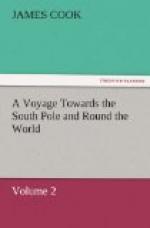Turtle, I am told, are to be found at this isle from January to June. The method of catching them is to have people upon the several sandy bays, to watch their coming on shore to lay their eggs, which is always in the night, and then to turn them on their backs, till there be an opportunity to take them off the next day. It was recommended to us to send a good many men to each beach, where they were to lie quiet till the turtle were ashore, and then rise and turn them at once. This method may be the best when the turtle are numerous; but when there are but few, three or four men are sufficient for the largest beach; and if they keep patroling it, close to the wash of the surf, during the night, by this method they will see all that come ashore, and cause less noise than if there were more of them. It was by this method we caught the most we got; and this is the method by which the Americans take them. Nothing is more certain, than that all the turtle which are found about this island, come here for the sole purpose of laying their eggs; for we met with none but females; and of all those which we caught, not one had any food worth mentioning in its stomach; a sure sign, in my opinion, that they must have been a long time without any; and this may be the reason why the flesh of them is not so good as some I have eat on the coast of New South Wales, which were caught on the spot where they fed.
The watch made 8 deg. 45’ difference of longitude between St Helena and Ascension; which, added to 5 deg. 49’ the longitude of James Fort in St Helena, gives 14 deg. 34’ for the longitude of the Road of Ascension, or 14 deg. 30’ for the middle of the island, the latitude of which is 8 deg. S. The lunar observations made by Mr Wales, and reduced to the same point of the island by the watch, gave 14 deg. 28’ 30” west longitude.
On the 31st of May, we left Ascension, and steered to the northward with a fine gale at S.E. by E. I had a great desire to visit the island of St Matthew, to settle its situation; but as I found the wind would not let me fetch it, I steered for the island of Fernando de Noronha on the coast of Brazil, in order to determine its longitude, as I could not find this had yet been done. Perhaps I should have performed a more acceptable service to navigation, if I had gone in search of the island of St Paul, and those shoals which are said to lie near the equator, and about the meridian of 20 deg. W.; as neither their situation nor existence are well known. The truth is, I was unwilling to prolong the passage in searching for what I was not sure to find; nor was I willing to give up every object, which might tend to the improvement of navigation or geography, for the sake of getting home a week or a fortnight sooner. It is but seldom that opportunities of this kind offer; and when they do, they are too often neglected.
In our passage to Fernando de Noronha, we had steady fresh gales between the S.E. and E.S.E., attended with fair and clear weather; and as we had the advantage of the moon, a day or night did not pass without making lunar observations for determining our longitude. In this run, the variation of the compass gradually decreased from 11 deg. W., which it was at Ascension., to 1 deg. W., which we found off Fernando de Noronha. This was the mean result of two compasses, one of which gave 1 deg. 37’, and the other 23’ W.




